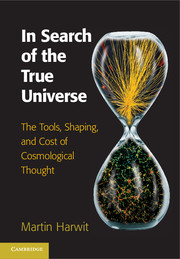Book contents
- Frontmatter
- Contents
- Preface
- Notes on Usage
- 1 The Nineteenth Century's Last Five Years
- Part I The Import of Theoretical Tools
- 2 An Overview
- 3 Conclusions Based on Principles
- 4 Conclusions Based on a Premise
- 5 Conclusions Based on Calculations
- 6 Ask the Right Questions, Accept Limited Answers
- Part II A National Plan Shaping the Universe We Perceive
- Part III The Cost of Discerning the True Universe
- Epilogue
- Appendix: Symbols, Glossary, Units and Their Ranges
- Index
- References
5 - Conclusions Based on Calculations
Published online by Cambridge University Press: 05 December 2013
- Frontmatter
- Contents
- Preface
- Notes on Usage
- 1 The Nineteenth Century's Last Five Years
- Part I The Import of Theoretical Tools
- 2 An Overview
- 3 Conclusions Based on Principles
- 4 Conclusions Based on a Premise
- 5 Conclusions Based on Calculations
- 6 Ask the Right Questions, Accept Limited Answers
- Part II A National Plan Shaping the Universe We Perceive
- Part III The Cost of Discerning the True Universe
- Epilogue
- Appendix: Symbols, Glossary, Units and Their Ranges
- Index
- References
Summary
The logic of well-founded but far-reaching theories may at times be extended to problems so far removed from normal experience that the derived results violate intuition. Doubts then arise about the validity of applying the theory to such extreme conditions, and the theory's original inventors may become its most severe critics.
A Problem Biding Its Time
When is the right time to ask a question? Some questions can be answered almost as soon as they are posed. Others cannot be answered either because they are awkwardly put or because the means for answering them are not at hand. One such question first surfaced late in the eighteenth century.
As early as 1783, the Reverend John Michell, an English natural philosopher and geologist, conceived of a star so compact and massive that its gravitational attraction would prevent light from escaping. He considered the motion of light in Newtonian terms, which suggested that the gravitational attraction of any star would slow down its emitted radiation. Although for most stars this deceleration might be minor, radiation escaping massive stars might have its speed appreciably diminished. For extremely massive compact stars, he thought the emitted light could actually come to a standstill before dropping back to the star's surface.
Michell was concerned not only with whether light could actually be prevented from escaping a star, but also with how we might recognize this. Perhaps his most important realization was that the existence of such a star might be inferred from the gravitational force it would exert on an orbiting companion.
- Type
- Chapter
- Information
- In Search of the True UniverseThe Tools, Shaping, and Cost of Cosmological Thought, pp. 76 - 96Publisher: Cambridge University PressPrint publication year: 2013



